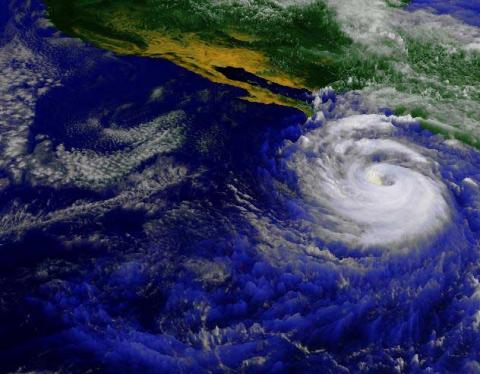Nora, developing in the Pacific during September of 1997, caused spectacular halos and other surprising phenomenon observed as far away as Oklahoma. Image by Laboratory for Atmospheres, NASA/GSFC.
Storms tracked by flight crews include tropical cyclones. Monster tropical cyclones are called hurricanes in the Atlantic, typhoons in the Pacific and cyclones in the Indian Ocean. Such storms first develop over the ocean, 8-15 degrees north and south of the equator.
Tropical cyclones develop into one of three types:
- Tropical depression (sustained winds at 20-33 knots);
- Tropical storm (sustained winds of 34-63 knots); and
- Hurricane (sustained winds of 64 knots or higher).
The weather service gives a name (in alphabetical order) to tropical storms and hurricanes, but only a hurricane has an "eye" at its center. Surrounding the hurricane's eye is its eyewall (where the storm's surface winds are greatest).
Once a tropical cyclone develops into a full-blown hurricane, it can move away from the place where it started. As the storm moves, its intensity can increase. It threatens everything in its path.
Mariners are especially at risk because such storms are more intense at sea. (Follow this link to view the effects of Hurricane Hugo. The photo was taken by a crew aboard a NOAA P-3, flying at 5000 feet, recording waves 60-80 feet high created by winds greater than 100 knots.)
It is possible for a hurricane to travel to the northern section of the North Atlantic, but it will start to dissipate when it passes over cooler waters. That's because the main source of energy for a hurricane is warm ocean water. A hurricane will also begin to dissipate when it makes landfall because the warm water (its energy source) is no longer there.
If a mariner at sea is unable to make safe harbor during a monster storm, the next best thing is to find cooler water as soon as possible. But mariners aren't always so fortunate. Some ships, like the Andrea Gail on October 28, 1991, are too far from land AND too far from cold water.


 Back
Back
 Next Chapter
Next Chapter

 Back
Back
 Next Chapter
Next Chapter


